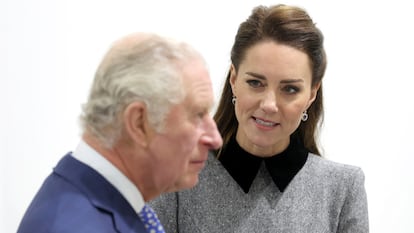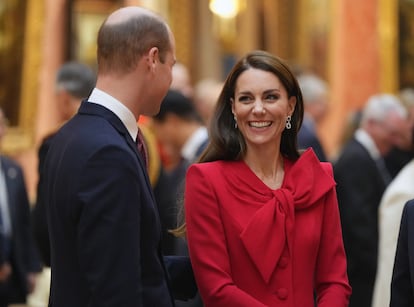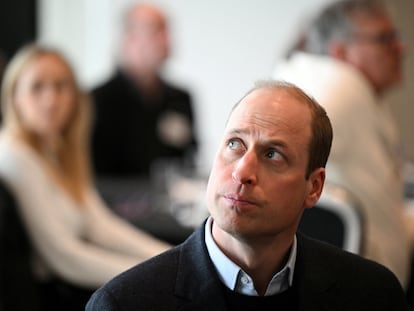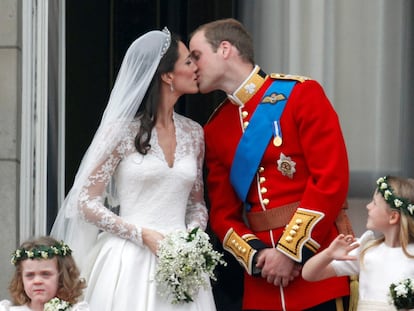Catherine, Princess of Wales: A PR crisis impossible for Kensington Palace to solve
The royal decided to tell the public that she has cancer after seeing the warm response’s to King Charles’ announcement

Two cancer cases in two public figures of immense importance in the United Kingdom and the rest of the world: a king, Charles III, and his daughter-in-law Catherine, Princess of Wales, the wife of the heir to the throne. Two very different PR strategies: one had successful results; the other sparked the most serious crisis of credibility the house of Windsor has seen in recent years.
Princess of Wales’ decision to finally follow in her father-in-law’s footsteps and tell the public about her illness has been met with an immense wave of solidarity and support. Her announcement has largely stopped the speculation about her health and redirected the failed communication strategy of the Kensington Palace, the official residence and name given to the office handling the affairs of the Prince and Princess of Wales.
Catherine made the decision to tell the public about her diagnosis after seeing the warm responses King Charles received to his announcement. But the truth is the princess’s personal circumstances never made such an announcement easy.
Indeed, not even her video message has completely stopped the criticism and conspiracy theories on social media. “What really, I think, annoyed me was seeing that she was then being revictimized by being blamed for not having come out immediately,” Imran Ahmed, chief executive of the Center for Countering Digital Hate, told the BBC. “I think it’s the inhumanity of the way that social media has made us behave, forcing people to talk about things that can be very deeply personal.”

Charles III is the head of state of the United Kingdom. He has a nearly constitutional and certainly political obligation to be transparent about his health. This hasn’t always been the case. Doctors hid the fact that George VI had lung cancer from the British and the monarch himself until the very end. His daughter, Queen Elizabeth II, also did not feel the need to explain her — generally robust — health. It was only through a newspaper exclusive that the British learned that she had been hospitalized with Covid-19 in October 2021.
“There is no doubt that we are living in an extremely difficult time for the monarchy, with King Charles undergoing treatment for his cancer [...] By revealing his problem, he has helped citizens become more aware of this disease. But the truth is that we do not know details about the type of cancer he suffers from,” Richard Fitzwilliams, writer and expert on royal affairs, tells EL PAÍS. “It is about finding a balance and this is difficult, because, of course, members of the royal family also have the right to privacy.”
Ending speculation about the king
The Buckingham Palace got it right by immediately reporting — albeit with limited details — the state of Charles III’s health as soon as his diagnosis was known in early February. Since then, the constant flow of videos, photos and messages from the king have satiated the curiosity of media and social networks. Charles III has been able to present an image of an active monarch, eager to return to his full duties, and stop any speculation in its tracks.
The Princess of Wales didn’t have that choice. She was recovering from a complicated “abdominal surgery” that she underwent in mid-January, and as a result, could not present a false image of normality. In addition to the shock of the cancer discovery and the need to carry out chemotherapy treatment, Catherine urgently needed to recover from the operation before she could begin the next, delicate stage of her treatment. And there were also her three children — aged five, eight and 10 — to think about. The princess had to find the right moment to tell them the news that was going to dramatically affect their family.
“This is not just an institution, it’s a family... You also have to remember they’re human beings,” Paddy Harverson, the couple’s friend and former communications advisor, said in defense of Catherine to the BBC. “You have to give them the space so while there might be communications [...] you also have to remember they are human beings and you have to follow their lead to a certain degree.”
There was a strategy, but it fell short and was ineffective. On January 17, the Kensington Palace reported that the princess had undergone “planned abdominal surgery.” An official statement warned that Catherine would remain in hospital for up to 14 days to recover, and that she would not resume public duties until after the Easter holidays, in mid-April. Kensington Palace even went so far as to tell the BBC, outside the official statement, that she did not have cancer. An unfortunate error, as later confirmed, that sought to temper the foreseeable commotion in the media and social networks. But in her video message on Friday, Catherine herself explained that cancer had been ruled out before the operation.
“Princess Kate could have garnered significant social capital with the public by strategically sharing her story and — like the King did with the global community of cancer patients — built a bridge of empathy, education [about cancer] and shared experience,” Terry Flynn and Alex Sévigny, two academics in communications management, wrote in an article. “Indeed, personal and discreet storytelling regarding her condition could have created a narrative that satisfied the media’s need to know while keeping the specifics of her condition beyond the view of the always peering British and global media.”
But the information that has been emerging in recent hours describes a 42-year-old woman worried about her three children, who has strengthened her bond with her father-in-law, King Charles. Both share a diagnosis that upsets millions of people. And it was precisely the king’s decision, observed by Middleton from her forced confinement, which encouraged her to follow in his footsteps, according to The Times. The princess recorded her video message last Wednesday, in Windsor Gardens, with the help of BBC Studios. The next day, she had lunch alone with the king and told him of her intentions. Late Friday afternoon, she announced what has been struggling with for the past two months.
The PR strategy had an immediate effect, and most media outlets opted for restraint and respect in their reporting on the Princess of Wales. But there will always be doubts as to whether the storm of speculation and conspiracy theories about Catherine’s health and whereabouts would have been prevented if the news was announced earlier. Or whether the process followed its own inevitable timeline and logic.
Sign up for our weekly newsletter to get more English-language news coverage from EL PAÍS USA Edition
Tu suscripción se está usando en otro dispositivo
¿Quieres añadir otro usuario a tu suscripción?
Si continúas leyendo en este dispositivo, no se podrá leer en el otro.
FlechaTu suscripción se está usando en otro dispositivo y solo puedes acceder a EL PAÍS desde un dispositivo a la vez.
Si quieres compartir tu cuenta, cambia tu suscripción a la modalidad Premium, así podrás añadir otro usuario. Cada uno accederá con su propia cuenta de email, lo que os permitirá personalizar vuestra experiencia en EL PAÍS.
¿Tienes una suscripción de empresa? Accede aquí para contratar más cuentas.
En el caso de no saber quién está usando tu cuenta, te recomendamos cambiar tu contraseña aquí.
Si decides continuar compartiendo tu cuenta, este mensaje se mostrará en tu dispositivo y en el de la otra persona que está usando tu cuenta de forma indefinida, afectando a tu experiencia de lectura. Puedes consultar aquí los términos y condiciones de la suscripción digital.
More information
Archived In
Últimas noticias
Maduro pleads not guilty before the federal court in New York: ‘I am still the president of Venezuela’
A new test can detect Alzheimer’s from a finger prick
UN team enters Sudanese city of El Fasher after paramilitary massacre: ‘It’s like a ghost town’
A recipe for resistance: Indigenous peoples politicize their struggles from the kitchen
Most viewed
- Gilles Lipovetsky: ‘If you want to live better and fall in love, take Prozac, don’t look to philosophy’
- Alain Aspect, Nobel laureate in physics: ‘Einstein was so smart that he would have had to recognize quantum entanglement’
- Alvin Hellerstein, a 92-year-old judge appointed by Bill Clinton, to preside over Maduro’s trial in New York
- Why oil has been at the center of Venezuela-US conflicts for decades
- Maduro’s downfall puts China’s relationship with Venezuela to the test











































